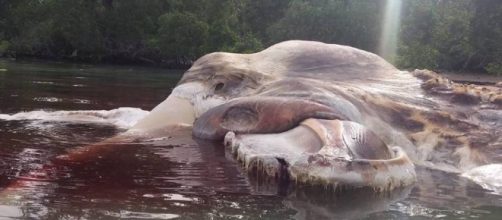A mysterious creature that was the size of a boat was recently spotted on a remote beach in Indonesia. The creature freaked out most of the locals and the press instantly went into a frenzy trying to figure out what it was. Several reports claimed that it was a giant squid or perhaps an unknown type of deep water animal. However, further investigation has revealed that the "monster" was apparently nothing more than a decomposing whale carcass.
A freakishly gruesome sight
The creature that was spotted on an Indonesian beach was estimated to be nearly 50 feet long.
The carcass settled near the shore along Hulung Beach on Seram Island, Indonesia and was first spotted by local residents who mistook it for a big boat. The blob of flesh also had a bizarre appearance and even had a red-colored goo oozing out of it. Due to the strange appearance and size of the carcass, it would be understandable for people to instantly jump into conclusions regarding its origin.
Scientific investigation
Upon close inspection of the washed up carcass, Alexander Werth, a whale biologist at Hampden-Sydney College in Virginia, claimed that the body could very well be a Baleen Whale. Some experts have predicted that it could be a Bryde's whale, although the species are not known to reach that size.
Other theories claim that it could also be a blue whale. Scientist over at the California Academy of Sciences also predicts that it could be a fin whale. It could also be a different kind of whale, but the scientists are at least certain that it belongs to the Balaenoptera family of whales.
According to experts, the dead giveaway that reveals that the creature is indeed a whale is due to its "throat pleats" and the clear upper jaw where the two rack of plates can be seen. The plates are used to filter out food within the whale's mouth.
Late stage of decay
Based on the images, experts have revealed that the beached whale is actually in an advanced state of decomposition. The way it is shaped it mostly due to the bacteria creating noxious gasses trapped within the whale's flesh and blubber.
The bacteria inside the whale continue to reproduce even when the creature has died, which results in foul and noxious gasses to be released.
Dead whales don't normally wash ashore as they mostly sink to the bottom to become food for other animals. However, there are instances where they die on the surface with bacterial gasses still trapped inside their body. Warm waters also contribute to the rapid growth of bacteria, which in turn causes the body of the dead animal to float.


